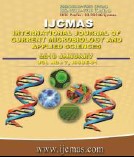


 National Academy of Agricultural Sciences (NAAS)
National Academy of Agricultural Sciences (NAAS)

|
PRINT ISSN : 2319-7692
Online ISSN : 2319-7706 Issues : 12 per year Publisher : Excellent Publishers Email : editorijcmas@gmail.com / submit@ijcmas.com Editor-in-chief: Dr.M.Prakash Index Copernicus ICV 2018: 95.39 NAAS RATING 2020: 5.38 |
An experiment was conducted to study the effect of exogenous application of boron and zinc at different concentrations at three important growth stages (flushing, flowering and fruiting) on leaf area, chlorophyll content, carotenoids, stomatal count and yield of cashew var. Bhaskara. Irrespective of growth stages, foliar application of zinc sulphate (0.5%) + borax (0.1%) was found to be superior in all the parameters. Out of six treatments, the highest chlorophyll content (chl a, chl b and chl t), carotenoids and leaf area were recorded in trees sprayed with zinc sulphate (0.5%) + borax (0.1%). At flushing stage, spraying with zinc sulphate (0.5%) + borax (0.1%) resulted in highest stomatal number (31.05) whereas unsprayed (control) trees recorded least stomatal number (12.18). Thus, leaf area, chlorophyll content, carotenoids and stomatal count were increased in trees sprayed with above combination of micronutrients than unsprayed trees. Spraying of zinc sulphate (0.5%) + borax (0.1%) recorded highest nut yield (10.80 kg/tree), whereas unsprayed trees recorded least nut yield (3.20 kg/tree). This study demonstrated the potential of zinc sulphate (0.5%) + borax (0.1%) in improving various biochemical parameters viz., chlorophyll ‘a’, chlorophyll ‘b’, total chlorophyll, carotenoids and leaf area in cashew which are important determinants in increasing cashew nut production.
 |
 |
 |
 |
 |